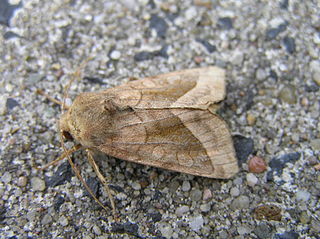
Hydraecia micacea, the rosy rustic, is a moth of the family Noctuoidea. It is found across the Palearctic realm from Ireland to Siberia. It reaches Japan and is introduced to eastern USA, Quebec and Ottawa.

Mythimna pudorina, the striped wainscot, is a species of moth of the family Noctuidae. It is found in the Palearctic realm. Also Armenia, Asia Minor and eastern Siberia.

Callopistria juventina, the Latin, is a moth of the family Noctuidae. The species is found across the Palearctic realm.

Mesapamea secalis, the common rustic, is a moth of the family Noctuidae. The species was first described by Carl Linnaeus in his 1758 10th edition of Systema Naturae. It is found in Europe, north-west Africa, Turkey and northern Iran.

Amolita perstriata is a species of moth in the family Erebidae first described by George Hampson in 1910. The species is found on the Bahamas. Its wingspan is about 22 mm.

Chersadaula ochrogastra is a species of moth in the family Oecophoridae. This species is endemic to New Zealand. It is classified as "Data Deficient" by the Department of Conservation.
Garrha mitescens is a moth in the family Oecophoridae. It was described by Edward Meyrick in 1914. It is found in Australia, where it has been recorded from Queensland and the Northern Territory.
Inga ancorata is a moth in the family Oecophoridae. It was described by Lord Walsingham in 1912. It is found in Costa Rica, Colombia, Guyana and Brazil.
Inga erythema is a moth in the family Oecophoridae. It was described by Thomas de Grey in 1912. It is found in Guyana, Brazil and Central America.
Agonopterix rubristricta is a moth in the family Depressariidae. It was described by Thomas de Grey, 6th Baron Walsingham, in 1912. It is found in Guatemala.
Dichomeris habrochitona is a moth in the family Gelechiidae. It was described by Thomas de Grey, 6th Baron Walsingham, in 1911. It is found in Panama.
Anarsia austerodes is a moth in the family Gelechiidae. It was described by Edward Meyrick in 1918. It is found in Namibia and South Africa.
Leuronoma eodryas is a moth of the family Gelechiidae. It was described by Edward Meyrick in 1918. It is found in South Africa.
Aristotelia howardi is a moth of the family Gelechiidae. It was described by Walsingham in 1909. It is found in Mexico (Sonora) and California.
Aristotelia penicillata is a moth of the family Gelechiidae. It was described by Thomas de Grey, 6th Baron Walsingham, in 1897. It is found in West Indies, where it has been recorded from Haiti.
Ornativalva heligmatodes is a moth of the family Gelechiidae. It was described by Thomas de Grey, 6th Baron Walsingham, in 1904. It is found in Algeria and Tunisia.
Gonionota erotopis is a moth in the family Depressariidae. It was described by Edward Meyrick in 1926.
Antaeotricha ceratistes is a moth in the family Depressariidae. It was described by Lord Walsingham in 1912. It is found in Mexico (Guerrero).
Stenoma canonias is a moth in the family Depressariidae. It was described by Edward Meyrick in 1913. It is found in French Guiana.
Bursadella acribes is a moth in the family Immidae. It was described by John Hartley Durrant in 1916. It is only known from Biak.




